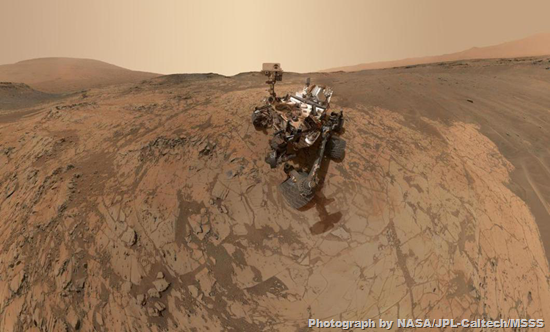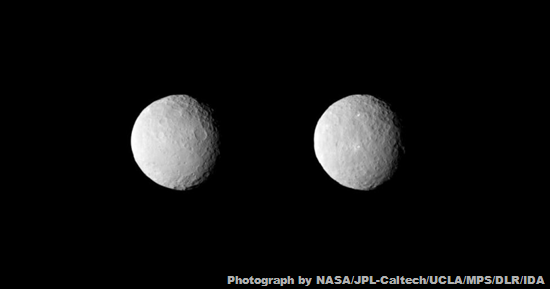
Week's Best Space Pictures: Curiosity Drills, Nebulae Illuminate, and Hubble Peers
By Jane J. Lee, National Geographic News, 27 February 2015.
By Jane J. Lee, National Geographic News, 27 February 2015.
Curiosity makes its third foray into Martian soil, nebulae light up a winter night, and Hubble peers into deep space in this week's best space photos.
1. Winter's Horseman
Both the Orion (left) and the Horsehead (right) Nebulae light up a winter's night over Tehran, Iran.
The Orion Nebula - located 1,300 light-years away from Earth - is an area where new stars are forming. To the naked eye, it appears as a tiny smudge below the belt in the Orion constellation.
The Horsehead Nebula - officially known as Barnard 33 - also acts as a stellar nursery, giving birth to low-mass stars. Researchers at Harvard College Observatory first imaged this famous celestial object in 1888, but they didn't discover it. That honour goes to Williamina Fleming, a maid in the home of astronomy professor Edward Pickering, who hired her to catalogue the stars he was imaging. It seems the astronomy professor wasn't satisfied by the work done by his male employees, and stated that his maid could do a better job. (See "6 Women Scientists Who Were Snubbed Due to Sexism.")
Fleming developed a star classification system - now known as the Pickering-Fleming system - based on a star's spectra, or how its light refracts through a prism. She went on to catalogue 10,000 stars over nine years. (See "Why It's Crucial to Get More Women Into Science.")
2. A Mojave Selfie
The Mars Curiosity Rover may be 140 million miles (225 million kilometres) away, but it can still send us selfies. Here is the intrepid robot at its second drilling site on Mount Sharp in an area of Mars called Mojave.
The rover's Mars Hand Lens Imager took a series of photos of the robot, which researchers then stitched together into Curiosity's self-portrait. To get a clean view, scientists used images that didn't show the rover's arm in a selfie pose. (Watch how Curiosity took a selfie two years ago.)
3. Star Light
This extreme ultraviolet view of the sun is perfect for seeing our star's outer atmosphere - or corona - ablaze with solar flares and massive outbursts called coronal mass ejections. The images also enable researchers to spot coronal holes, open regions in the sun's magnetic field that appear as dark blotches.
Their darker appearance is due to their less dense and cooler nature relative to their surroundings. Those openings also allow particles to escape into space and are the source of solar winds.
4. On Approach
NASA's Dawn spacecraft captured these images of Ceres as the dwarf planet completed one full rotation. Dawn is scheduled to settle into orbit around Ceres on March 6. The pockmarked planet will be the spacecraft's second stop; Dawn first studied the asteroid Vesta. (Learn why Vesta may have been the source of Earth's water.)
Researchers believe both Vesta and Ceres were born early in our solar system's history. They hope that studying these early inhabitants will give them an idea of the solar system's early conditions. (See "New Photos of Dwarf Planet Ceres Reveal Mysterious Bright Spots.")
5. A Deep View
This tiny slice of the southern constellation Tucana is the deepest visible and ultraviolet light image ever taken of a part of the universe. It was possible thanks to the Hubble Space Telescope.
6. A New Hole
The NGC 2276 galaxy, shown here in x-rays (pink) and visible light (red, green, and blue), harbours a newly discovered object known as an intermediate-mass black hole (inset). Smaller than supermassive black holes, intermediate-mass black holes may eventually grow as big as their gargantuan brethren. (See "Gigantic Black Hole Discovered From the Dawn of Time.")
7. Drilling Down
The Mars Curiosity rover drilled a dime-size hole into a rock dubbed "Telegraph Peak" on Mount Sharp. It's the third such site for the robot, and studying the chemistry of the rock could give researchers a glimpse into how ancient, wet environments on Mars dried out.
Photo gallery by Sherry L. Brukbacher.







No comments:
Post a Comment
Please adhere to proper blog etiquette when posting your comments. This blog owner will exercise his absolution discretion in allowing or rejecting any comments that are deemed seditious, defamatory, libelous, racist, vulgar, insulting, and other remarks that exhibit similar characteristics. If you insist on using anonymous comments, please write your name or other IDs at the end of your message.